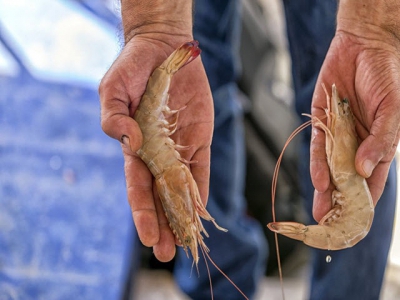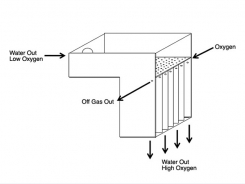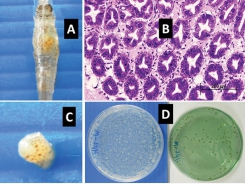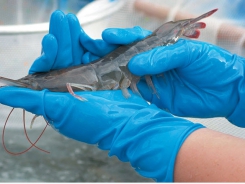Low-fishmeal feeds may see performance boost from supplement blend

Shrimp on low fishmeal diets may see improved weight gain, digestibility and feed conversion when supplemental protease, carbohydrase and organic acid salts are added, say researchers.
Shrimp on low-fishmeal diets see performance boost from feed additive blend © GettyImages/Funtay
A team of researchers from Canada and China explored the use of dietary protease, encapsulated organic acid salts and carbohydrase in the diets of shrimp as an alternative to higher fishmeal levels.
The group published its work in the journal Aquaculture.
“The objective of the present study was to investigate the individual and combined effects of supplemental protease, multi-carbohydrase and micro-encapsulated organic acid salts in low fish meal diet on growth, feed utilization and intestine histology of Pacific white shrimp,” the researchers said.
The researchers found that shrimp on the positive control, or high fishmeal diet, did have the highest weight gain and best feed conversion ratio, while those on the negative control, or non-supplemented low fishmeal diet, had the worst growth.
However, shrimp on the supplemented diets saw improvements in feed conversion and weight gain compared to those on the negative control diet, they said. Shrimp on all the supplemented diets had improved results, and better apparent digestibility coefficient (ADC) for crude protein and those receiving additional protease saw a boost to ADC of dry matter.
“The findings showed that the individual or combined supplementation of protease, carbohydrase and micro-encapsulated organic acid salts in low fish meal diet (10% fish meal) could improve the growth performance and nutrient utilization of Pacific white shrimp,” the researchers said.
Move to low fish-meal diets
As global aquaculture expands, the limited availability of fishmeal has developed as a factor restricting future growth of the industry, the researchers said.
Animal and plant proteins have been used to substitute for fishmeal, they said. However, alternative ingredients can add anti-nutrients including phytate and non-starch polysaccharide, have imbalanced amino acids, reduce feed palatability and limit digestibility.
Several nutritional strategies have been explored to improve the use of alternative proteins, they said. These include use of supplemental essential amino acids, acidifiers and the addition of enzymes to boost nutrient digestibility.
“Among these enzymes, phytase, carbohydrase and protease are the most commonly used enzymes."
Why add protease, carbohydrase and organic acid salt?
Adding plant-based proteins to fish or shrimp diets can limit nutrient digestibility and result in poor performance and gastrointestinal health, the researchers said. However, protease can breakdown proteins and anti-nutrient elements.
“The inclusion of 175 mg/kg protease in low fishmeal diet significantly improved growth and nutrient digestibility and retention in gibel carp (Carassius auratus gibelio) (Shi et al., 2016),” they said. “Studies on rainbow trout (Oncorhynchus mykiss) (Denstadli et al., 2011; Drew et al., 2005), black carp (Mylopharyngodon piceus) (Chen et al., 2009) and tilapia (Oreochromis niloticus × O. aureus) (Li et al., 2016) also showed the improved growth performance by the addition of protease.”
Similar results with some crustaceans also have been reported, they said.
Indigestible carbohydrates also may be a challenge when plant-based proteins are used as NSP can reduce feed use and negatively influence animal performance, they said. “Carbohydrases are a group of enzymes that catalyze a reduction in the molecular weight of polymeric carbohydrates, and the supplementation of carbohydrase in feed could mitigate the adverse effects of corresponding NSP,” they added.
Plant proteins also can alter intestinal health for aquatic species, the researchers said. However, acidifiers have been linked to improved growth potentially by improving gut health.
Based on shrimp feeding behavior, it is important to encapsulate organic acids used in shrimp feed to limit leaching, they said.
Although there have been studies exploring the use of protease, carbohydrase and acidifiers in shrimp diets, little work has been done examining a combined use of the feed additives, they said.
“Enzymes could improve the overall nutritional value of low fish meal diet, and acidifiers are believed to enhance growth by improving gut health,” they said. “The combined use of enzymes and acidifiers is given high expectation to play a big role in shrimp diet.”
Feeding trial details
During the feeding trial, 1,440 shrimp received one of nine diets for a period of 49 days, the researchers said. Two control diets were developed – a positive control (PC), with 20% fishmeal and a negative control (NC) with 10% fishmeal and a combination of soybean meal and meat-and-bone-meal.
“A protease complex (P, 175 mg/kg), a multi-carbohydrase (C, 100 mg/kg) and a micro-encapsulated organic acid salt blend (O, 825 mg/kg) were supplemented to the NC diet individually or in combination to formulate another seven diets (P, C, O, P + C, P + O, C + O, P + C + O),” they added.
A sample of shrimp was collected at the start of the trial to check for whole-body proximate composition, they said. At the end of the trial, a sample of shrimp hepatopancreases was collected to check of digestive enzyme activity and the intestinal tracts were taken for histological assessment.
A selection of shrimp also was weighed and collected to assess whole body proximate composition, they said. Shrimp survival, weight gain (WG), feed conversion ratio (FCR), protein efficiency ratio (PER), protein retention efficiency (PRE) and lipid retention efficiency (LRE) were calculated.
Following the sampling, the remaining shrimp were fed for 10 days and fecal matter was gathered to assess nutrient digestibility, the researchers said.
Results
Overall survival rates were similar for shrimp on all diets, the researchers said. Shrimp on the NC diet had lower WG and worse FCR than the PC shrimp.
“The individual or combined supplementation of protease, multi-carbohydrase and organic acid salts significantly improved WG and decreased FCR when compared to the NC group,” they said. “Among the supplemented groups, P + C + O group had the best growth with higher WG and lower FCR than the NC group.”
Shrimp body composition was similar for all diets, they said. However, shrimp on the NC diet had lower PER, PRE, LRE, ADC of dry matter (ADCDM) and ADC of crude protein (ADCCP), then shrimp on the PC diet.
Shrimp getting the feed supplements saw improved PER, PRE and LRE compared to those on the NC diet, the researchers said. “The supplementation of protease individual or in combination significantly improved ADCDM compared to the NC group (P < .05), and the P + O + C group reached the similar level as the PC group,” they added.
“The ADCCP of all supplemented groups were significantly higher than the NC group,” they said. “In addition, the P + O and P + C + O groups showed no significant difference in ADCCP with the PC group.”
Similarly, shrimp on the NC diet had the lowest protease and amylase activity in the hepatopancreas, they said. Diets with supplemental protease improved protease activity and amylase activity saw a boost from additive mutli-carbohyrdase.
Shrimp on the NC diet also had the lowest villus height, while intestinal villus for shrimp on the PC feed was “more orderly,” they said. Shrimp on diets supplemented with organic acid salts either alone or in combination had results similar to the PC-diet shrimp.
“The individual or combined supplementation of protease, carbohydrase and organic acid salts in a low fish meal diet (10% fish meal) significantly improved the growth performance and feed utilization of Pacific white shrimp,” the researchers said. “The combination of the three additives showed better effects than their individual supplementation, but still showed lower growth than the positive diet containing 20% fish meal.”
Source: Aquaculture
Authors: W. Yao, X. Li, M. Chowdhury, J. Wang, X. Leng
Related news
Tools

Phối trộn thức ăn chăn nuôi

Pha dung dịch thủy canh

Định mức cho tôm ăn

Phối trộn phân bón NPK

Xác định tỷ lệ tôm sống

Chuyển đổi đơn vị phân bón

Xác định công suất sục khí

Chuyển đổi đơn vị tôm

Tính diện tích nhà kính

Tính thể tích ao




 Patent issued for indoor recirculating aquaculture system
Patent issued for indoor recirculating aquaculture system  Biosecurity principles for sustainable production using SPF shrimp
Biosecurity principles for sustainable production using SPF shrimp